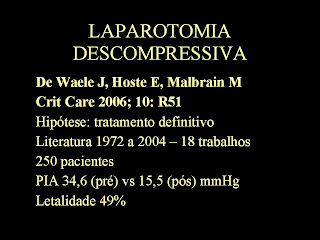Os Cateteres de Artéria pulmonar estão desaparecendo do cenário da medicina intensiva.
Me pergunto se mudaram os pacientes ou mudamos nós . Os novos meios de monitoração não são tão utilizados e não chegam a “substituir” quantitativamente (e há quem diga qualitativamente já que todos seus estudos são validados contra o “padrão ouro”-advinhem ? o próprio S.Ganz.).
Segue o interessante artigo abaixo que é do tipo “ver para crer”
Sei que , apesar de não ser fã, muito do aprendizado e da fisiologia que sabemos de pacientes críticos veio do uso diário destes meios de monitoração que perigam ir parar no museu...
Jorge Salluh
PAC Use in US Has Declined By 65% in a Decade
July 24, 2007 (White River Junction, VT)– A new study shows that use of the pulmonary artery catheter (PAC) decreased by 65% in the US between 1993 and 2004 [1]. This is likely the result of growing evidence that this invasive procedure does not reduce mortality for hospitalized patients, say Drs Renda Soylemez Wiener and H Gilbert Welch (Department of Veterans Affairs Medical Center, White River Junction, VT) in their paper published in the July 25, 2007 issue of the Journal of the American Medical Association (JAMA).
In one editorial accompanying the study [2], critical-care doctor and contributing JAMA editor Dr Derek C Angus (University of Pittsburgh School of Medicine, PA) says that while the many PAC trials do not settle the controversy surrounding it, they do illustrate that "its benefits, if any, are not easily harnessed." Wiener concurs. She told heartwire: "Most of the studies that have been done show that physicians have trouble interpreting the information provided by PAC."
In another editorial [3], Dr Gordon D Rubenfeld (University of Toronto, ON) and colleagues say: "The 40-year story of the PAC is nearing its end. It is a cautionary tale of rapid adoption and slow evaluation of a monitoring device that, when used correctly, provides exquisitely detailed physiologic data that, regrettably, does not appear to benefit patients."
Use of PAC declined by 81% in MI and by 65% in HF
Wiener and Welch explain that the PAC first became available as a practical diagnostic tool in 1970 and was rapidly embraced by critical-care physicians, making measurements such as cardiac output and pressure within the small vessels in the lungs accessible to physicians at the bedside. "Many physicians assumed that these numbers could guide treatment and ultimately reduce mortality in critically ill patients. Within several years, PAC was widely used throughout the US. In the 1980s, 20% to 43% of seriously ill patients who were hospitalized were reported to undergo the procedure," the authors say.
But Wiener explained to heartwire that PAC is an invasive procedure, which carries a number of risks, such as cardiac arrhythmias, bleeding, and infection, and by the mid and late 1980s, there were challenges to the benefits of this procedure. "And a number of newer technologies were introduced that can offer some of the same information in a less invasive way," she noted.
In addition, during the past five years multiple randomized trials and a meta-analysis have demonstrated that PAC has no impact on the risk of death in diverse populations of critically ill patients.
But until now, it is has not been known how this information has changed the use of this procedure, Wiener explained.
Thus, she and Welch examined trends in the use of PAC from 1993 to 2004 using data from all US states contributing to the Nationwide Inpatient Sample. They found that use of PAC from 1993 to 2004 decreased by 65%, from 5.66 to 1.99 per 1000 medical admissions. Among common diagnoses associated with PAC, the decline was most prominent for MI, where use decreased by 81%; its use in heart failure also fell by 65%.
In particular, the decline appears to have begun after the reporting of one specific trial, a multicenter observational study by Connors et al that suggested an increased risk of death with PAC, the researchers note. This was first presented at the 1994 American Thoracic Society conference and published in 1996, along with an accompanying editorial that was "strongly worded," and called for a moratorium on PAC use until a randomized controlled trial could be conducted.
"It is possible that [as a result of the Connor et al study] certain prominent critical-care physicians acted as early adopters and not only discontinued PAC placement but also influenced the local culture in their hospitals through their role as opinion leaders," they say.
"Most doctors have responded appropriately to the evidence that PAC does not reduce mortality, which is reflected in the national decrease in PAC use that we have observed," Wiener said.
Several options for those still using PAC
Wiener acknowledges, however, that some doctors remain proponents of PAC and that it is still used in some institutions. In their editorial, Rubenfeld et al give advice on the use of the "increasingly rare procedure of PAC," explaining that hospitals continuing to use it should think about several options.
"First, centers performing only a few PAC procedures should consider not doing any. Second, if PAC use is continued, the procedure should be limited to a small number of skilled clinicians.
"Third, consider alternate hemodynamic monitoring tools, but consider them skeptically until convincing outcome data are available. . . . Fourth, continued use of PAC demands intensive evaluation and education," the editorialists write.
"In the waning years of PAC, when the risks of infrequent use may outweigh any unproven benefit, it is more important than ever to remain vigilant for common errors in PAC placement and data interpretation," they conclude.
1. Wiener RS and Welch HG. Trends in the use of pulmonary artery catheter in the United States, 1993-2004. JAMA 2007; 298: 423-429.
2. Angus DC. Caring for the critically ill patient. Challenges and Opportunities. JAMA 2007; 298: 456-457.
3. Rubenfeld GD, McNamara-Aslin E, Rubinson L. The pulmonary artery catheter, 1967-2007 Rest in peace? JAMA 2007; 298: 458-461.






















